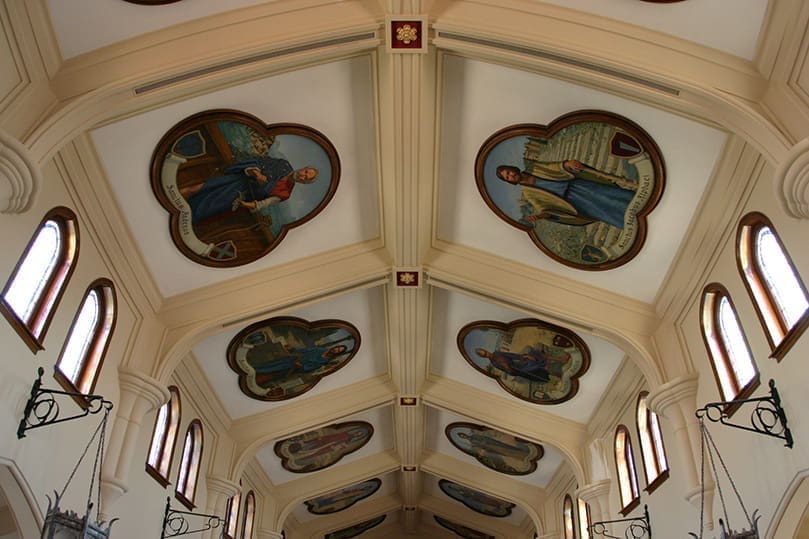 Photo By Michael Alexander
Photo By Michael Alexander
Atlanta
Shrine Is City Of Atlanta’s Oldest Parish
By STEPHEN O'KANE, Staff Writer | Published October 29, 2009
On Martin Luther King Jr. Drive near the state Capitol, visitors to Atlanta will most likely pass another building of importance—a church that has a significant place in Catholic history and in the history of Georgia.
Atlanta Catholics completed their first church building in 1848. Not yet named, it was known simply as “the Catholic Church” and it stood on the same site as the present Shrine of the Immaculate Conception at 48 Martin Luther King Jr. Drive. It was a simple wood frame structure like many surrounding buildings at the time.
Behind the altar, parishioners hung a reproduction oil painting of Bartolomé Esteban Murillo’s “Immaculate Conception.” From this painting, the Shrine would eventually get its name.
Bishop Ignatius Reynolds, of Charleston, South Carolina, dedicated the church in 1849. A year later Georgia was established as a Catholic diocese in its own right. The spiritual direction of Atlanta’s Catholics transferred from Charleston to the Diocese of Savannah, shepherded by Bishop Francis Gartland.
Already historic as the site of Atlanta’s first Catholic Church, the Shrine became indelible in the history of Catholicism in Georgia during the Civil War and through the leadership of its pastor, Father Thomas O’Reilly.

Savannah’s Bishop William Gross dedicated the Shrine of the Immaculate Conception on December 10, 1873. Photo By Michael Alexander
He is credited with saving the Shrine and several other neighboring Christian churches when everything around them was destroyed.
When the citizens of Atlanta who had fled during the siege returned at the end of the war, they found their city almost totally destroyed by fire. The spared churches, including the Shrine, became places of refuge to temporarily house the homeless returnees.
Rather than starting to repair their church, which had been damaged by shelling, Atlanta Catholics decided to build a new church. They moved the old wood frame building to the east onto an adjacent lot and began construction of the new church on the same site as the original one. When Father O’Reilly died on Sept. 6, 1872, at the age of 41, he was buried in a vault under the new church. A second pastor, Father Thomas F. Cleary, was also buried there in the 1800s.
Over the decades, the existence of the vault under the church was obscured. Ironically, a serious fire that gutted the historic Shrine in 1982 led to the rediscovery of the vault. The area was restored and is now appropriately marked and can be viewed. The Shrine was also rebuilt honoring its stature as a part of the irreplaceable history not just of Catholic Atlanta, but all of Atlanta and Georgia.

Bryan Anthony, second from left, leads a parish outreach ministry that feeds the homeless and poor each morning, Monday through Friday. The ministry distributes sandwiches and drinks to those who show up. Anthony is assisted by daily by (l-r) Leo Dugger, William Brown and David Swift. Photo By Michael Alexander
The same spirit of outreach and ministry that characterized the Shrine at its inception lives on today. Parishioners are involved in providing food and shelter for Atlanta’s homeless and are welcoming to visitors and to local Catholics who come to the Shrine.
Susan Kokoszka, a parishioner for about 12 years, is actively involved with outreach efforts. Her experience at the parish has been nothing but positive. Being downtown makes the Shrine different from suburban parishes, she said.
“The outreach ministries really deal with the needs of the city,” she said. Those who need to be helped are right outside the door of the church. “Many parishioners are involved.”
Kokoszka is closely involved with St. Francis Table, a ministry that began over 20 years ago during the period when Franciscans friars staffed the Shrine. The name originated with their imitation of St. Francis of Assisi.
A small group of parishioners got together and started a soup kitchen since there seemed to be a void in available food for the hungry on Saturdays. Monday through Friday churches in the area ministered to and fed the nearby homeless, but there was nothing available on Saturday. As a result, St. Francis Table was established.
Currently St. Francis Table feeds more than 500 people every Saturday. The only requirement for people to be fed is that they are hungry. Several parishes, religious denominations, colleges, high schools and companies participate in preparing the food for St. Francis Table. Each week one or more organizations take the lead in preparing the food.

The Shrine’s statue of the Pieta was carved in Italy. The statue survived a 1982 church fire. Photo By Michael Alexander
The ministry is funded through private donations and grants and does not receive monies from the Shrine or from the Archdiocese of Atlanta.
During the chillier months in Atlanta, the Shrine also offers, in partnership with its neighbor, Central Presbyterian Church, the Central Night Shelter. From Nov. 1 through March 31, the churches house up to 30 people a night, giving them a place to sleep and a hot meal.
The historic community holds a special place in the hearts of Catholics as is evidenced by the commitment of its parishioners who come from over 20 different zip codes around metro Atlanta.
“You do meet people that don’t necessarily live near you,” said Kokoszka, adding that it is a great way to get to know people throughout the archdiocese.
“A lot of people say (the Shrine) reminds them of their old church,” she said. “People like modern, but they are very fond of traditional design.”
After many decades of special devotion to Mary, in 1954 Immaculate Conception Church was designated a shrine (a church hallowed by history) by decree of Savannah-Atlanta Archbishop Gerald P. O’Hara. Archbishop O’Hara affirmed that the beloved historic church would now be known as the Shrine of the Immaculate Conception and the Shrine of the entire Atlanta diocese.